Cardiolipin deficiency in Rhodobacter sphaeroides alters the lipid profile of membranes and of crystallized cytochrome oxidase, but structure and function are maintained
- PMID: 21476578
- PMCID: PMC3097902
- DOI: 10.1021/bi101702c
Cardiolipin deficiency in Rhodobacter sphaeroides alters the lipid profile of membranes and of crystallized cytochrome oxidase, but structure and function are maintained
Abstract
Many recent studies highlight the importance of lipids in membrane proteins, including in the formation of well-ordered crystals. To examine the effect of changes in one lipid, cardiolipin, on the lipid profile and the production, function, and crystallization of an intrinsic membrane protein, cytochrome c oxidase, we mutated the cardiolipin synthase (cls) gene of Rhodobacter sphaeroides, causing a >90% reduction in cardiolipin content in vivo and selective changes in the abundances of other lipids. Under these conditions, a fully native cytochrome c oxidase (CcO) was produced, as indicated by its activity, spectral properties, and crystal characteristics. Analysis by MALDI tandem mass spectrometry (MS/MS) revealed that the cardiolipin level in CcO crystals, as in the membranes, was greatly decreased. Lipid species present in the crystals were directly analyzed for the first time using MS/MS, documenting their identities and fatty acid chain composition. The fatty acid content of cardiolipin in R. sphaeroides CcO (predominantly 18:1) differs from that in mammalian CcO (18:2). In contrast to the cardiolipin dependence of mammalian CcO activity, major depletion of cardiolipin in R. sphaeroides did not impact any aspect of CcO structure or behavior, suggesting a greater tolerance of interchange of cardiolipin with other lipids in this bacterial system.
Figures
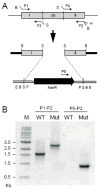
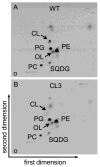
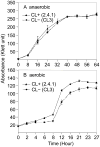
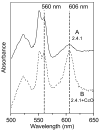
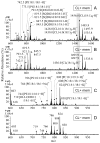
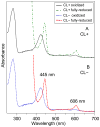
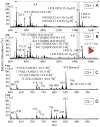
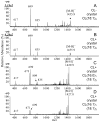
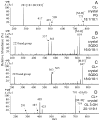
Similar articles
-
Cardiolipin Alters Rhodobacter sphaeroides Cell Shape by Affecting Peptidoglycan Precursor Biosynthesis.mBio. 2019 Feb 19;10(1):e02401-18. doi: 10.1128/mBio.02401-18. mBio. 2019. PMID: 30782656 Free PMC article.
-
Combined genetic and metabolic manipulation of lipids in Rhodobacter sphaeroides reveals non-phospholipid substitutions in fully active cytochrome c oxidase.Biochemistry. 2011 May 17;50(19):3891-902. doi: 10.1021/bi1017039. Epub 2011 Apr 22. Biochemistry. 2011. PMID: 21476580 Free PMC article.
-
A Cardiolipin-Deficient Mutant of Rhodobacter sphaeroides Has an Altered Cell Shape and Is Impaired in Biofilm Formation.J Bacteriol. 2015 Nov;197(21):3446-55. doi: 10.1128/JB.00420-15. Epub 2015 Aug 17. J Bacteriol. 2015. PMID: 26283770 Free PMC article.
-
The Interplay among Subunit Composition, Cardiolipin Content, and Aggregation State of Bovine Heart Cytochrome c Oxidase.Cells. 2020 Dec 3;9(12):2588. doi: 10.3390/cells9122588. Cells. 2020. PMID: 33287231 Free PMC article. Review.
-
Cardiolipin synthesis for the assembly of bacterial and mitochondrial membranes.J Lipid Res. 2008 Aug;49(8):1607-20. doi: 10.1194/jlr.R700018-JLR200. Epub 2007 Dec 12. J Lipid Res. 2008. PMID: 18077827 Free PMC article. Review.
Cited by
-
Lipid Composition Affects the Efficiency in the Functional Reconstitution of the Cytochrome c Oxidase.Int J Mol Sci. 2020 Sep 23;21(19):6981. doi: 10.3390/ijms21196981. Int J Mol Sci. 2020. PMID: 32977390 Free PMC article.
-
Cardiolipin Alters Rhodobacter sphaeroides Cell Shape by Affecting Peptidoglycan Precursor Biosynthesis.mBio. 2019 Feb 19;10(1):e02401-18. doi: 10.1128/mBio.02401-18. mBio. 2019. PMID: 30782656 Free PMC article.
-
Two Distinct Cardiolipin Synthases Operate in Agrobacterium tumefaciens.PLoS One. 2016 Jul 29;11(7):e0160373. doi: 10.1371/journal.pone.0160373. eCollection 2016. PLoS One. 2016. PMID: 27472399 Free PMC article.
-
Cryo-EM structure of the photosynthetic RC-LH1-PufX supercomplex at 2.8-Å resolution.Sci Adv. 2021 Jun 16;7(25):eabf8864. doi: 10.1126/sciadv.abf8864. Print 2021 Jun. Sci Adv. 2021. PMID: 34134992 Free PMC article.
-
Less is More: Membrane Protein Digestion Beyond Urea-Trypsin Solution for Next-level Proteomics.Mol Cell Proteomics. 2015 Sep;14(9):2441-53. doi: 10.1074/mcp.R114.042572. Epub 2015 Jun 16. Mol Cell Proteomics. 2015. PMID: 26081834 Free PMC article. Review.
References
-
- Nussberger S, Doerr K, Wang DN, Kuhlbrandt W. Lipid-protein interactions in crystals of plant light-harvesting complex. J Mol Biol. 1993;234:347–356. - PubMed
-
- Bogdanov M, Sun J, Kaback HR, Dowhan W. A phospholipid acts as a chaperone in assembly of a membrane transport protein. J Biol Chem. 1996;271:11615–11618. - PubMed
Publication types
MeSH terms
Substances
Grants and funding
LinkOut - more resources
Full Text Sources

